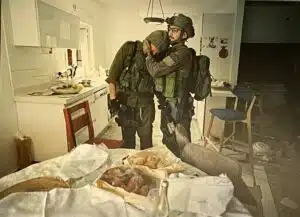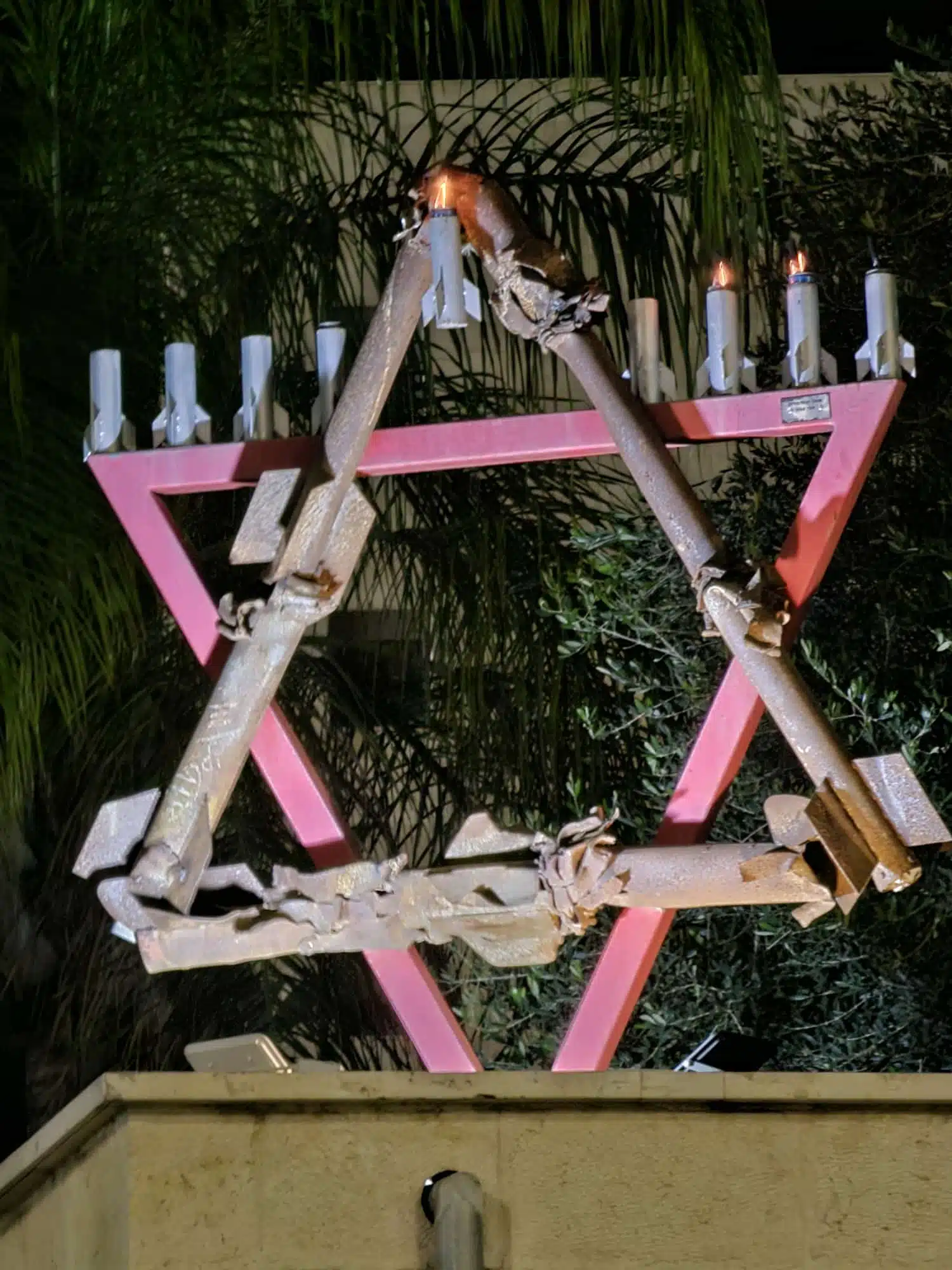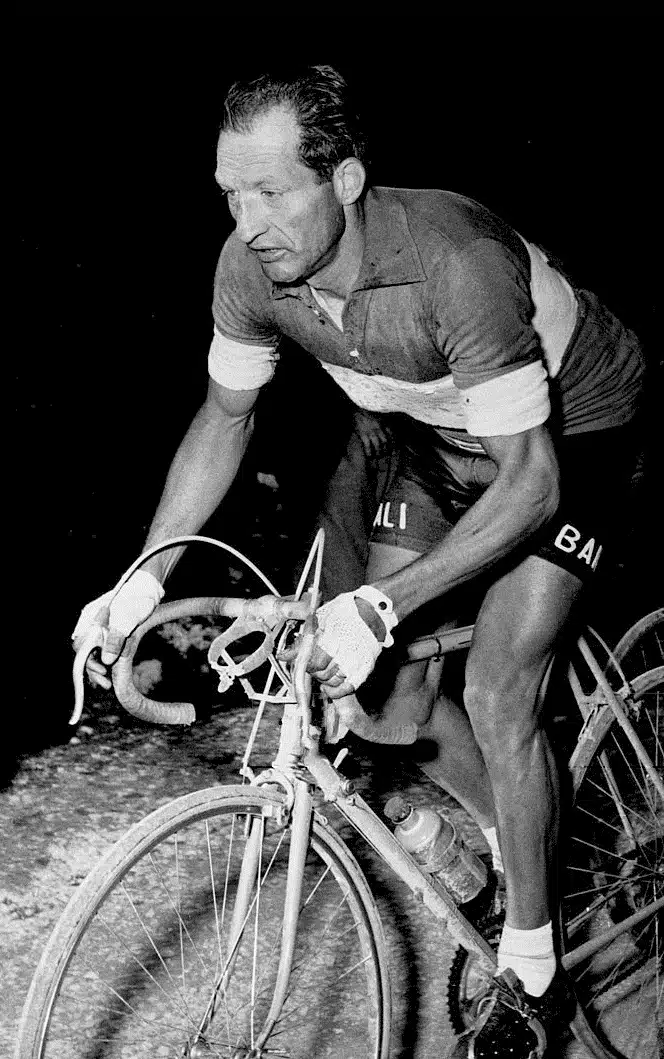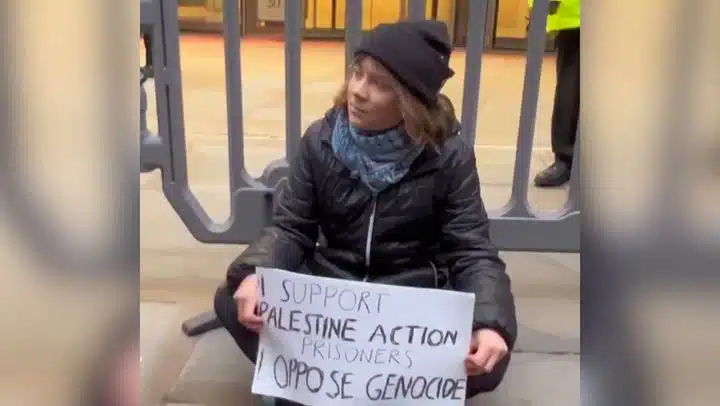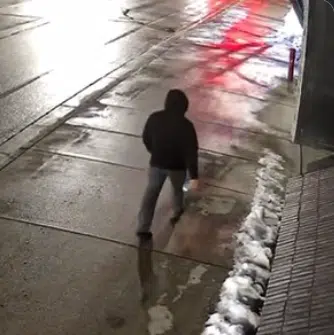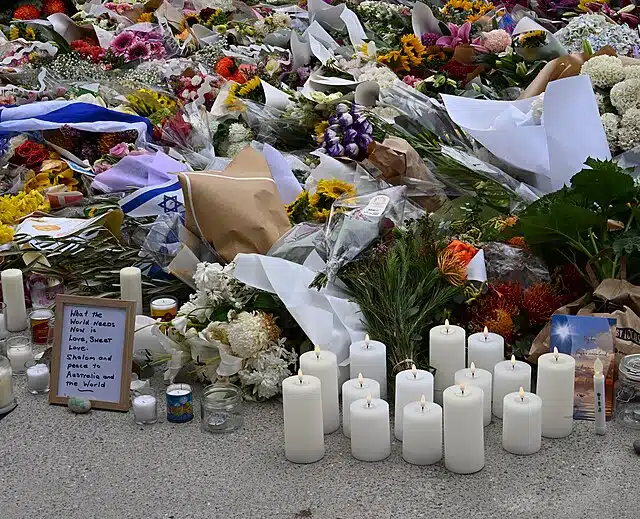|
Getting your Trinity Audio player ready...
|
Before the Massacre — The World That Was
At the Return to October exhibit in Glilot, just outside Tel Aviv, visitors come face to face with the raw evidence of October 7th. The displays include weapons, orders, and religious items left behind by Hamas terrorists after their massacre across southern Israel — along with materials later uncovered by the IDF in Gaza.
Room by room, the exhibit retraces how the morning of Simchat Torah 2023 — which fell on Shabbat — became the deadliest day in Israel’s history, and the worst single day for the Jewish people since the Holocaust. More than 1,200 people were slaughtered that morning — shot, burned alive, raped, and mutilated. Entire families were incinerated in their homes. The kibbutzim lay in ruins, as Hamas terrorists dragged 251 men, women, and children into Gaza.
The exhibit begins with a long corridor lined with a mural of the kibbutzim in the Gaza Envelope — communities that once embodied the quiet rhythm of life along Israel’s southern border. The scenes of everyday peace — children playing, families gathering, fields stretching toward the horizon — blend seamlessly into images from the Nova music festival, where young Israelis danced beneath open skies.
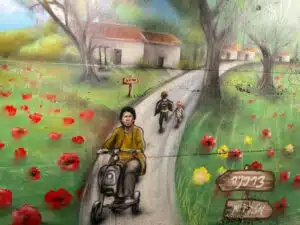
When the Music Gave Way to Sirens
A graffiti artist who survived the massacre painted the murals. He had been at the Nova festival only hours before the attack began. Later, he painted what had once been beautiful — the world as it was before dawn broke into horror.
These murals belong to October 6 — to a world that ended in an instant. On October 7, that world was torn apart. There will always be a before and after that day — a moment that cleaved history in two.
At the corridor’s end hangs a poem by Chaim Nachman Bialik, Israel’s national poet. Written after the 1903 Kishinev pogrom, “The City of Slaughter” captures the unending echo of Jewish suffering.

One line reads: “To hear the cry of their agony, their weeping everlasting…”
Over a century may divide Kishinev from October 7, yet Bialik’s lament still speaks to our time. The anguish that swept through the Jewish world then reverberates again today — in Israel and across the Jewish world — a haunting reminder that the same hatred endures, only wearing new masks.
Manuals of Terror — The Orders Behind the Massacre
Behind every atrocity of October 7 lay a blueprint. In the next rooms, those blueprints stand exposed — original documents recovered from the bodies of Hamas terrorists and from inside Gaza: field manuals, maps, operational orders, and handwritten pages of indoctrination that turned ideology into slaughter.
One such order, titled Toofan al-Aqsa — “The Al-Aqsa Flood” — was issued by the Izz al-Din al-Qassam Brigades on October 6, 2023, one day before the massacre. Hamas refers to October 7 by this name, framing it as a divine act of vengeance and a defense of the Al-Aqsa Mosque.
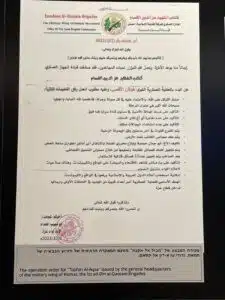
One page instructs units to raid kibbutzim “with the aim of killing and capturing prisoners without distinguishing between soldiers and civilians.” Another orders them to “capture both soldiers and civilians, and hold them for negotiation purposes.”
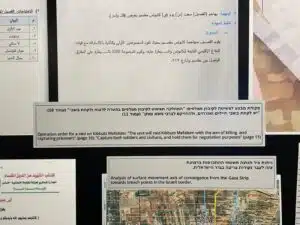
A torn map of Kibbutz Be’eri found next to a terrorist’s body shows every house numbered and every street divided into attack zones labeled A, B, and C. The detail leaves no doubt that the slaughter was meticulously organized, planned down to each doorway.
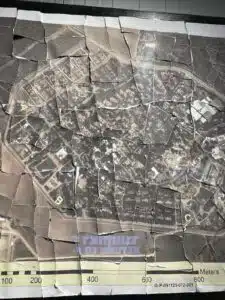
Faith Turned Into a Weapon
Hamas’s elite Nukhba unit left behind specially printed Qurans and operational booklets that instruct fighters which prayers and verses to recite before each military action. Fatwas and committee rulings sit alongside those materials, invoking faith to justify murder and hostage-taking. Nearby, physical tools — tasers, zip ties, syringes, tourniquets, and capsules — demonstrate how Hamas fused religious indoctrination with the practical means of murder and abduction.
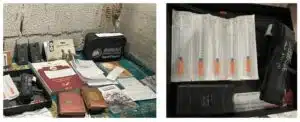
The documents reveal more than routes and weapons. They include theological guidance that redefines civilians as lawful targets. One document states:
“Every Jew is considered a combatant, including women and youth, even if unarmed.”
Taken together, these items point to a wider mission — an ideological campaign with global aims.
A War Against “Infidels”: Ideology and Global Aims
October 7 was one brutal manifestation of a far broader goal: a holy war against “infidels.” The ideology driving Hamas targets Israel and the United States first and foremost, while naming their allies — including the United Kingdom — as part of the same enemy camp.
Recovered notebooks and guidance materials make that intent explicit. They describe an ongoing jihad not confined to Israel’s borders but directed against the broader Western world. Civilian soft targets — synagogues, schools, and community centers — appear alongside military objectives, showing that no distinction is made between combatants and civilians, or between battlefield and home front.
The materials reveal how theology and violence converge: religious rulings that invoke faith to sanctify murder and hostage-taking lie beside operational notes and the physical tools of abduction — tasers, zip ties, syringes, and tourniquets. Together, they expose a worldview in which faith is weaponized to justify global war against all who stand outside an Islamist order.
One audio clip recovered from a Hamas terrorist’s phone captures the depth of this fanaticism: moments after murdering civilians on October 7, he called his parents in Gaza — proudly boasting of how many Jews he had killed. His father’s voice, recorded on the line, responds with joy and praise. It is a chilling testament to an ideology that sanctifies slaughter as devotion.
Psychological Warfare: Terror by Design
Hamas wages its war not only with bullets and blades, but with words and images. Across the burned-out homes and shattered streets lay Arabic graffiti, blood-smeared slogans, and handwritten notes — threats meant to deepen the horror and instill fear.
One such note, found inside a house in Kibbutz Be’eri, read: “We will bring death to you, get out of our land before it is too late. We are people who love death. Flee from our land. Palestinian resistance.”
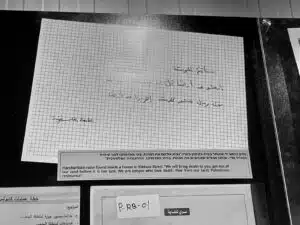
These were not random expressions of rage. They were instruments of psychological warfare, calculated to terrorize civilians and desecrate the very spaces where families had lived and died. Filmed scenes of devastation, recorded chants, and celebratory broadcasts reinforced the same message — to glorify murder, humiliate the victims, and spread fear far beyond Israel’s borders.
Hamas choreographed the October 7 attacks for maximum impact — not only on the ground but on the screen. The group crafted its propaganda to reverberate worldwide, amplifying terror and rallying followers under the banner of jihad.
Weaponizing Faith and Humanity — Turning Civilian Life Into a Battlefield
Beyond ideology, the exhibit exposes Hamas’s battlefield method — the systematic exploitation of civilians. Hamas embeds itself within Gaza’s neighborhoods, turning homes, schools, hospitals, and mosques into weapons of war. It chooses these sites precisely because they endanger civilians. The more densely it hides among the vulnerable, the louder its accusations against Israel of “indiscriminate” targeting. Civilian life becomes both shield and strategy, ensuring that every Israeli act of self-defense can be manipulated for global condemnation.
Evidence throughout the exhibit exposes this method: weapons hidden in mosques, UN facilities, and “civilian” homes; command centers buried beneath hospitals; tunnel openings concealed in children’s rooms and playgrounds. Each display dismantles Hamas’s claim of victimhood and shows its deliberate use of its own people as human armor.
UNRWA: The Humanitarian Façade
One of the exhibit’s most damning revelations centers on UNRWA — the United Nations agency meant to aid Palestinians but long entangled in Hamas’s machinery of hate. What was built to serve civilians has instead been weaponized to sustain terrorism.
The proof is overwhelming. UNRWA facilities acted as extensions of Hamas’s infrastructure. Its schools hid tunnels, its classrooms stored weapons, and its compounds launched rockets.
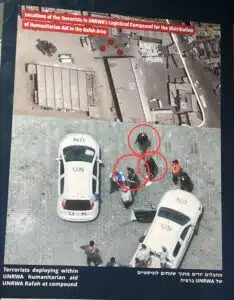
Investigations and battlefield intelligence confirm that many UNRWA employees were not bystanders but participants. Several were active members of Hamas and Palestinian Islamic Jihad. They used their positions to move materials, relay information, and indoctrinate Gaza’s children.
The textbooks and youth-program materials on display — funded by international donors, including the European Union — drip with antisemitic incitement. They glorify “martyrdom,” erase Israel from maps, and depict Jews as enemies to be destroyed. It is the manufacturing of hate in UN classrooms — financed by the world’s democracies.
UNRWA’s presence in Gaza did not protect civilians; it made them human shields. The exhibit leaves no doubt: the world’s largest humanitarian organization in Gaza became one of Hamas’s greatest assets.
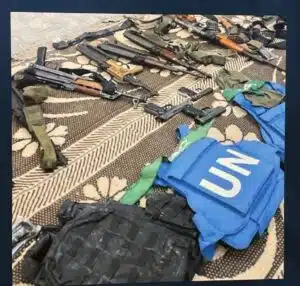
The War for the Lens — How Hamas Exploits the Press
First, the exhibit reveals another weapon Hamas wields with precision: the global media. From the start, the group understood perception can rival rockets. In addition, winning sympathy abroad could undermine Israel’s right to self-defense.
According to documents recovered from the October 7 attackers, Hamas leaders, including Yahya Sinwar, ordered units to film everything. In other words, propaganda was built into the operation. Hamas fighters were told to kill, torture, and humiliate — and, moreover, to record every atrocity. The objective was clear: create images so horrific they would shatter Israeli society. As a result, fear would paralyze communities. Ultimately, October 7 was also a psychological attack.
Meanwhile, every terrorist carried a camera. In addition, “professional photographers” — often Hamas operatives posing as journalists — documented and distributed footage. In fact, investigations revealed many of these “journalists” were Hamas or Palestinian Islamic Jihad members. For example, some also worked for Reuters, The Associated Press, CNN, and Al Jazeera.
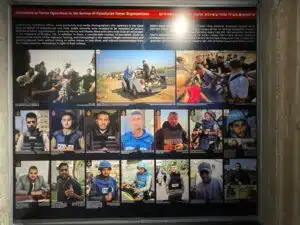
Hamas filmed and released the photographs and videos themselves — from the lynching of an Israeli soldier to the public parading of Shani Louk’s desecrated body — flooding global networks with their propaganda. Western institutions even honored some of these images as “photojournalism.” But they were never acts of documentation; they were acts of terror — staged to horrify Israelis, glorify the killers, and rally global sympathy for Hamas’s cause.
Online, the narrative of aggressor and victim inverted. Terror became “resistance.” Self-defense became “aggression.” The exhibit’s curators make this clear: the cameras were as much a weapon as the rifles.
Indoctrination and Jihad Education — Raising a Generation to Hate
The final rooms expose the roots of Hamas’s violence: a culture of indoctrination that begins in childhood and ends in martyrdom.
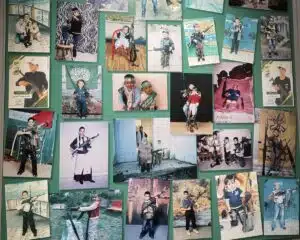
Exhibit materials show schoolbooks — all produced by the Palestinian Authority’s Ministry of Education and Ministry of Culture. Every page teaches that Jews are evil, Israel must be destroyed, and death in battle is the highest aspiration.
Among the displays is a series of illustrated textbooks where cartoon characters carry rifles and praise “martyrs.” Others glorify real-life terrorists — assassins, suicide bombers, and gunmen — as role models for Gaza’s children. Maps within the same books erase the State of Israel entirely, replacing Israeli cities with “Palestinian” ones to teach that Israel does not exist. These materials are not fringe; they are the official curriculum in Hamas-run schools.
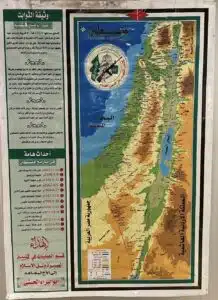
In Gaza, the hatred runs deeper than any single textbook. Mein Kampf — Nazi leader Adolf Hitler’s manifesto — remains one of the best-selling Arabic-language books after the Qur’an. It’s celebrated in local markets and frequently cited in Hamas propaganda. Readers study it not as history but as instruction — reinforcing the same genocidal ideology that drives the movement’s war on the Jewish people.
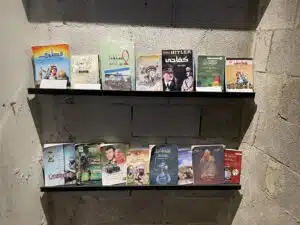
The curriculum does more than glorify martyrs; it sanctifies action. In practice, classroom guides and youth handbooks equate jihad with worship, teaching that fighting is a religious duty on par with prayer. Moreover, the exhibit displays letters and rulings that instruct teachers and youth leaders to treat Jews as enemy combatants, regardless of age or gender. As a result, that theology turns education into mobilization, creating a system designed not to teach children, but to weaponize them.
Stories of Heroism and Resistance
Amid the devastation, one room honors the extraordinary heroism of those who fought back, saved lives, and refused to surrender. Visitors can hear recordings of bravery, including first responders rescuing anyone they can find as they ran towards the carnage. Each story restores humanity to the darkness. It reminds visitors that, amid the terror of October 7, countless Israelis faced evil with extraordinary courage.
Artifacts of Evil and Remembrance
Among the exhibits lies a blood-stained vest once worn by Hamas leader Yahya Sinwar — a stark reminder of the man who planned the October 7 massacre and sent thousands to murder in the name of Allah.

Just beyond that, a long corridor brings visitors face to face with the full cost of that day. Along the walls, thousands of photographs depict men, women, and children murdered on October 7. Together, they form a display reminiscent of Yad Vashem’s haunting Hall of Names. As visitors move through the corridor, the faces seem to watch them pass — their silent presence demanding remembrance and justice. Ultimately, it becomes the emotional climax of the exhibit: a confrontation not with ideology, but with humanity.
Remembrance as Defiance
The Return to October is not merely an exhibit; it is a reckoning. Every artifact testifies to a single truth: Hamas planned, sanctified, and celebrated the October 7 massacre.

What emerges is a portrait of a movement at war not only with Israel, but with humanity itself. It turns faith into a weapon, civilians into shields, and children into soldiers.
Standing amid the remnants of that day, visitors grasp that October 7 was not only an assault on a nation. It was an assault on the very idea of human conscience.
To walk through The Return to October is to witness evidence, not symbolism. Yet it also demands something more: remembrance as defiance. Every fragment on display demands remembrance — a stand against those who twist history and deny the truth. In a world quick to distort, this exhibit restores moral sight. Documenting evil is not an act of despair. It is an act of resistance — a vow to expose those who murdered in darkness to the light of history.
